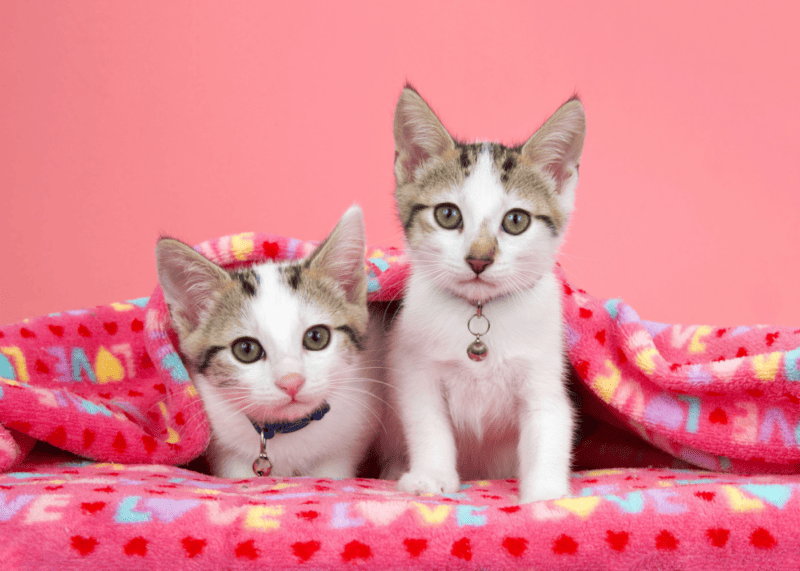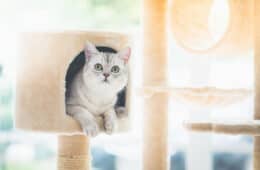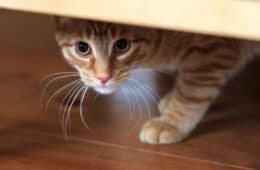Cat collars: they're more than just a fashion statement. Equipped with the right ID tag or contact details, they can be a lifeline for a lost cat. Additionally, cat collars safety is essential for every cat owner.
Imagine the scene: your beloved pet slips out unnoticed. Thanks to her collar, she's recognized as a lost housecat, not mistaken for a feral. That collar could make all the difference, guiding her safely back home.
We all enjoy the cute look of a collared cat, don't we? And the internet seems to agree.
While researching this piece, we dug into the most searched cat collar terms online. Disregarding the unsettling top result - "cat shock collar" - we found that fashion ruled the roost.
Searches for "rhinestone cat collar", "Louis Vuitton cat collar", "leather cat collar", and "embroidered cat collars" topped the charts.
But safety? That didn't pop up until the twelfth spot.
However, when you're collar shopping for your cat, safety should top your list. Our feline friends love a good climb or a narrow squeeze. Those with outdoor access can find even more danger.
After all, we can't cat-proof the whole neighborhood. Picture your cat leaping from a shelf, collar snagging on a hook.
A safe cat collar can be the difference between a fright and a tragedy. It's up to you to make the right choice for your furry friend.
Decoding the ID Tag: The Lifeline of Your Cat
Why are ID tags so crucial? They're your cat's voice when she can't speak for herself. If your cat wanders off, the ID tag tells her story. It reassures people she's not feral. It helps her find her way back home.
ID tags come in different forms. Traditional metal or plastic tags are common. So are slide-on tags, which sit flat against the collar. Digital QR code tags are on the rise. They hold more info and connect to online profiles.
What should go on the tag? Your contact details top the list. Include your name, phone number, and address if it fits.
If your cat has medical needs, consider noting it. Lastly, remember to keep the information current. Outdated info won't get your furry friend back home.
With the right ID tag, you give your cat a voice and a ticket back home. It's an essential part of your cat's safety toolkit.
See This Slide-On ID Tag On Amazon.
Safe Style: Selecting the Right Collar for Your Precious Cat
What's a safe collar for your cat? It's one that lets her escape when caught.
Two types lead the pack: elastic and breakaway collars.
Elastic collars are made of stretchy material that allows them to grow larger as the cat pushes against a collar that is caught in something. The cat can wriggle its head out of the collar that way and break free.
Breakaway collars have a special clasp that breaks open when enough pressure is applied. The body weight of a cat caught up against a peg should be enough to make the collar break open and let the cat fall freely and safely to the ground.
Cats come in various sizes, so make sure you get the right collar size for yours.
The best way to find what size your feline companion requires is by measuring the girth of the neck and then adding an inch to that to make sure that the collar is loose enough.
Once you get your cat collar of choice, you can adjust it for an even more precise fit.
Safe doesn't mean dull. Plenty of fun, fashionable options exist. You'll find embroidered safety collars, silky ones, and even rhinestone-studded styles. With the right safe collar, your cat can look good and stay safe.
Check out the collars category in our reviews threads for even more fashionable and safe cat collars.
Material World: Weighing Your Options in the Cat Collar Market
Choosing the right collar material is crucial. Let's look at two common types: leather and nylon.
Leather collars shout style. They're sturdy and long-lasting. But they're not for every cat. Leather can be heavy, especially for kittens. It also gets rigid in cold weather.
Nylon collars are light and durable. They dry fast when wet. They also offer more adjustability. But beware of low-quality nylon. It can fray and even cut into your cat's skin.
Kittens need special attention. They grow quickly. Adjustable and lightweight collars suit them best. Avoid heavy or rigid materials.
Senior cats also need care. Choose soft, comfortable materials. A collar that's too heavy or tight may strain their neck.
Your cat's age and lifestyle help decide the best material. By picking the right one, you ensure your cat's comfort and safety.
SIGN UP FOR THECATSITE'S EMAIL UPDATES >
The Bell Debate: To Ring or Not to Ring
Bell collars for domestic cats have sparked ongoing discussions among pet owners. The use of these collars raises questions about their impact on hunting behavior and the well-being of our feline companions.
Let's explore the pros and cons of bell collars to shed light on this debate.

Pros of Bell Collars:
Improved Awareness: Bell collars provide an audible cue, alerting owners to their cat's location. This can be especially beneficial in situations where a cat has accidentally gotten out of the house or into a location that is not typical.
Safety For Other Animals: By wearing a bell collar, cats give a heads-up to other animals (or smaller pets), giving them a chance to escape or take precautions.
Cons of Bell Collars:
Impaired Hunting Skills: The ringing sound of a bell can hinder a cat's hunting prowess. It may frustrate them and diminish their ability to practice their natural instincts effectively.
Discomfort and Stress: Some cats may find the constant noise and weight of the bell collar uncomfortable, causing stress or anxiety. It's important to monitor their behavior and ensure their well-being while wearing the collar.
The decision to use a bell collar for domestic cats involves considering the pros and cons. It's crucial to assess your cat's individual temperament and their environment to ensure their safety and well-being.
Collar Care: Keeping It Clean and Comfortable
Taking proper care of your cat's collar is essential to ensure its cleanliness and comfort. Let's explore some easy-to-follow tips for regular cleaning and know the signs when it's time to replace the collar.
Regular Cleaning Tips:
- Check the Label: Before cleaning the collar, always refer to the manufacturer's instructions for specific care guidelines. Different materials may require different cleaning methods.
- Handwashing: In most cases, handwashing is the safest and most effective method. Use mild soap or pet-friendly detergent and lukewarm water to gently clean the collar. Avoid harsh chemicals or abrasive scrubbing that could damage the collar.
- Thorough Rinse: After washing, make sure to rinse the collar thoroughly to remove any soap residue. Residual soap can cause skin irritation or discomfort for your cat.
- Drying: Allow the collar to air dry completely before putting it back on your cat. Avoid using high heat or direct sunlight, as it may cause shrinkage or damage to certain materials.
Signs the Collar Needs Replacing:
- Visible Wear and Tear: Regularly inspect the collar for signs of wear and tear. If you notice frayed edges, loose stitching, or significant deterioration, it's time to replace the collar for your cat's safety.
- Fading or Discoloration: Over time, collars may lose their color or become faded due to exposure to sunlight or regular use. If the discoloration is significant or affects the collar's visibility, consider replacing it.
- Damage or Breakage: If the collar has experienced damage or breakage, such as a broken buckle or a stretched-out elastic, it's crucial to replace it promptly. A compromised collar may not provide the necessary security for your cat.
- Size Incompatibility: As your cat grows or gains/loses weight, their collar size may need adjustment. If the collar becomes too tight or too loose, it's advisable to replace it with the appropriate size to ensure your cat's comfort and safety.
By following these cleaning tips and staying attentive to signs of wear, you can maintain a clean and comfortable collar for your beloved feline companion.
See This Hypoallergenic Cat Shampoo On Amazon.
When Things Go Wrong: Dealing with Collar Injuries and Mishaps
Collar injuries or mishaps can happen despite our best efforts. It's important to be prepared and know how to handle such situations.
Let's explore common collar injuries and mishaps and learn how to treat them, as well as when to seek veterinary help.
Common Injuries and How to Treat Them:
- Neck Irritation or Chafing: If you notice signs of redness, irritation, or chafing around your cat's neck, remove the collar immediately. Keep the area clean and dry, and avoid using any harsh chemicals or ointments. Consider using a hypoallergenic or softer collar material to prevent further irritation.
- Collar Hair Matting: Long-haired cats may experience hair matting beneath the collar. Gently remove any mats using your fingers or a wide-toothed comb. Regularly groom your cat to prevent future matting issues.
When to Seek Veterinary Help:
- Severe Injuries: If your cat experiences a significant injury while wearing a collar, such as deep cuts, bleeding, or obvious fractures, seek veterinary help immediately. Apply pressure to control bleeding and keep your cat as calm and comfortable as possible.
- Swallowed Collar Parts: In cases where a collar becomes damaged or your cat manages to chew off and swallow parts of it, contact your veterinarian right away. Swallowed collar parts can pose a choking hazard or lead to gastrointestinal issues.
- Persistent Discomfort: If your cat continues to exhibit discomfort or behavioral changes even after addressing minor collar-related issues, it's advisable to consult your veterinarian. They can assess your cat's condition and determine if there are underlying factors contributing to the discomfort.
Remember, it's crucial to prioritize your cat's safety and well-being. Regularly check the collar for any signs of discomfort, and if an injury or mishap occurs, take appropriate action promptly.
Making the Safe Choice
In the journey of choosing a collar for your beloved cat, prioritizing safety is paramount. Let's recap the importance of safe collars and encourage a focus on safety over aesthetics.
Recap of the Importance of Safe Collars:
Identification and Safety: Collars provide a means of identification, allowing lost cats to be easily reunited with their owners. This crucial aspect ensures the well-being and safety of our furry companions.
Preventing Accidents: Safe collars help prevent accidents and injuries. By using breakaway or quick-release collars, we reduce the risk of collar-related incidents, such as entanglement or choking.
Comfort and Well-being: Choosing a collar that fits properly and is made of comfortable materials enhances your cat's well-being. It reduces the chances of irritation, hair matting, or discomfort that can result from ill-fitting or irritating collars.
By making safety the top priority when selecting a collar for your cat, you ensure their overall welfare and reduce potential risks. Remember, the bond with your cat goes beyond appearance, and their safety should be at the forefront of your decision-making process.
SIGN UP FOR THECATSITE'S EMAIL UPDATES >
Comments? Leave them using the form below. Questions? Please use the cat forums for those!
You might also like:
10 Essential Cat Safety Rules You Need To Know
Cat Safety Tips For Your Home & Garden [By Room]
Note: We may get commissions for purchases made through links on this page.






One comment on “Cat Collars Safety Guide”